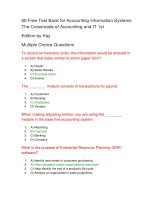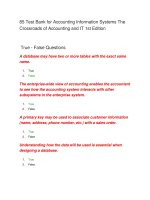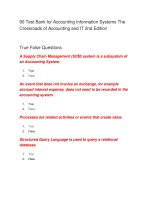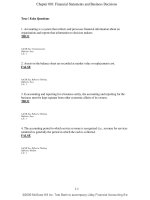136 test bank for horngrens accounting the financial chapters 10th edition
Bạn đang xem bản rút gọn của tài liệu. Xem và tải ngay bản đầy đủ của tài liệu tại đây (195.43 KB, 39 trang )
136 Test Bank for Horngrens Accounting The Financial
Chapters 10th Edition
True False Questions - - Multiple Choice Questions
The field of accounting that focuses on providing information for external
decision makers is:
1.
A. managerial accounting.
2.
B) financial accounting.
3.
C) cost accounting.
4.
D) nonmonetary accounting.
Which of the following is a characteristic of a limited-liability company (LLC)?
1.
A. An LLC's life is terminated at any member's choice or death.
2.
B) Each member of an LLC is liable only for his or her own actions.
3.
C) An LLC must have more than five members.
4.
D) The income of members from an LLC is not taxed.
Which of the following is an external user of a business' financial
information?
1.
A. customers
2.
B) cost accountant
3.
C) company manager
4.
D) the board of directors
Which of the following is the correct accounting equation?
1.
A. Assets + Liabilities = Equity
2.
B) Assets = Liabilities + Equity
3.
C) Assets + Revenues = Equity
4.
D) Assets + Revenues = Liabilities + Expenses
The Public Company Accounting Oversight Board (PCAOB) was created by
the:
1.
A. Sarbanes-Oxley Act (SOX)
2.
B) International Accounting Standards Board (IASB)
3.
C) Institute of Management Accountants (IMA)
4.
D) American Institute of Certified Public Accountants (AICPA)
The field of accounting that focuses on providing information for internal
decision makers is:
1.
A. managerial accounting.
2.
B) financial accounting.
3.
C) nonmonetary accounting.
4.
D) governmental accounting.
The formation of a partnership firm requires a minimum of:
1.
A. four partners.
2.
B) three partners.
3.
C) one partner.
4.
D) two partners.
30 years ago, Star Grocer Corporation had purchased a building for its
grocery store by paying $30,000. Based on inflation estimates, the amount of
the building has been adjusted in the accounting records. The building is now
reported at $75,000 in the financial statements of Star Grocer. Which of the
following concepts or principles of accounting is being violated?
1.
A. going concern assumption
2.
B) monetary unit assumption
3.
C) economic entity assumption
4.
D) cost principle
Which of the following statements is true of a sole proprietorship?
1.
A. A sole proprietorship joins two or more individuals as co-owners.
2.
B) The sole proprietor is personally liable for the liabilities of the business.
3.
C) A sole proprietorship is taxed separately from the owner.
4.
D) A sole proprietorship does not terminate at the choice or death of the owner.
A debt that a business owes to an outside party is called:
1.
A. an asset.
2.
B) a liability.
3.
C) stockholders' equity.
4.
D) revenue.
________ are professional accountants who serve the general public, not one
particular company.
1.
A. Certified public accountants
2.
B) Certified management accountants
3.
C) Cost accountants
4.
D) Controllers
Which of the following organizations is responsible for the creation and
governance of accounting standards in the United States?
1.
A. Financial Accounting Standards Board
2.
B) Institute of Management Accountants
3.
C) American Institute of Certified Public Accountants
4.
D) Securities and Exchange Commission
The Sarbanes-Oxley Act (SOX) made it a criminal offense to:
1.
A. transfer shares of stock.
2.
B) issue debentures.
3.
C) declare bankruptcy.
4.
D) falsify financial information.
Joshua Thomas is the owner of Nexus Inc., a manufacturer and retailer of
computer hardware. Joshua recently bought a new car as a gift for his
daughter. Since Joshua paid for the car from the earnings of the business, he
recorded it in the books of Nexus as an asset. Which of the following
concepts or principles of accounting is Joshua violating?
1.
A. monetary unit assumption
2.
B) economic entity assumption
3.
C) cost principle
4.
D) going concern assumption
The owner's claim to the assets of the business is called:
1.
A. return on assets.
2.
B) expenses.
3.
C) equity.
4.
D) debt.
Scott's Camera Shop started the year with total assets of $80,000 and total
liabilities of $40,000. During the year, the business earned revenues of
$120,000 and incurred expenses of $70,000. Scott made no additional capital
contributions during the year, but did make withdrawals of $60,000. What is
the amount of owner's equity at the end of the year?
1.
A. $70,000
2.
B) $120,000
3.
C) $30,000
4.
D) $60,000
GAAP are the rules that govern accounting in the United States. The acronym
GAAP in this statement refers to:
1.
A. Globally Accepted and Accurate Policies.
2.
B) Global Accommodation Accounting Principles.
3.
C) Generally Accredited Accounting Policies.
4.
D) Generally Accepted Accounting Principles.
Viva Inc. produces and sells coffee beans. This month it earned $500 by
selling coffee beans to Jeffery Inc. The $500 received by Viva is its:
1.
A. revenue.
2.
B) equity.
3.
C) gain.
4.
D) debt.
Which of the following organizations requires publicly owned companies to
be audited by independent accountants (CPAs)?
1.
A. Securities and Exchange Commission (SEC)
2.
B) Public Company Accounting Oversight Board (PCAOB)
3.
C) Financial Accounting Standards Board (FASB)
4.
D) American Institute of Certified Public Accountants (AICPA)
David has decided to open an auto-detailing business. He will pick up an
automobile from the client, take it to his parents' garage, detail it, and return it
to the client. If he does all of the work himself and takes no legal steps to form
a special organization, which type of business organization, in effect, has he
chosen?
1.
A. Limited-liability company
2.
B) Partnership
3.
C) Corporation
4.
D) Sole proprietorship
Which of the following users would rely on management accounting
information for decision-making purposes?
1.
A. potential investors
2.
B) creditors
3.
C) customers
4.
D) company managers
Gunnie Inc., located in Texas, records business transactions in dollars and
disregards changes in the value of a dollar over time. Which of the following
accounting assumptions does this represent?
1.
A. economic entity assumption
2.
B) going concern assumption
3.
C) accounting period assumption
4.
D) monetary unit assumption
As per the ________, the entity will remain in operation for the foreseeable
future.
1.
A. economic entity concept
2.
B) monetary unit assumption
3.
C) going concern assumption
4.
D) cost principle
Caleb Brown is the sole owner of a bicycle sales and repair shop from several
years. Which of the following business types would limit Caleb's personal
liability exposure to the entity's debts?
1.
A. Partnership
2.
B) Limited-liability company
3.
C) Sole proprietorship
4.
D) Limited-liability partnership
According to the ________, the acquired assets should be recorded at the
amount actually paid rather than at the estimated market value.
1.
A. going concern assumption
2.
B) economic entity concept
3.
C) cost principle
4.
D) monetary unit assumption
Corporate ownership is a very popular type of ownership in the United States.
Which of the following is a major reason that corporate ownership is popular?
1.
A. Stockholders have limited liability for the debts of the corporation.
2.
B) Most corporations are small or medium-sized.
3.
C) The life of a corporation is limited by the death of the owner.
4.
D) A corporation is usually managed by the owners.
Lorna Smith decided to start her own CPA practice as a professional
corporation, Smith CPA PC. Her corporation purchased an office building for
$35,000 that her real estate agent said was worth $50,000 in the current
market. The corporation records the building as a $50,000 asset because
Lorna believes that is the real value of the building. Which of the following
concepts or principles of accounting is being violated?
1.
A. cost principle
2.
B) economic entity assumption
3.
C) monetary unit assumption
4.
D) going concern assumption
Managerial accounting provides information to:
1.
A. internal decision makers.
2.
B) outside investors and lenders.
3.
C) auditors.
4.
D) taxing authorities.
The taxable income of a sole proprietorship is:
1.
A. combined with the personal income of the proprietor.
2.
B) not combined with the proprietor's personal income.
3.
C) not taxable.
4.
D) handled similarly to that of a corporation.
Which of the following statements best defines financial statements?
1.
A. Financial statements are the information systems that record monetary and
nonmonetary business transactions.
2.
B) Financial statements are the verbal statements made to business news
organizations by chief financial officers.
3.
C) Financial statements are documents that report on a business in monetary terms,
providing information to help people make informed business decisions.
4.
D) Financial statements are plans and forecasts for future time periods based on
information from past financial periods.
The economic resources of a business such as furniture, building, and land
are its:
1.
A. liabilities.
2.
B) revenues.
3.
C) assets.
4.
D) withdrawals.
Which of the following is a characteristic of a corporation?
1.
A. A corporation is owned by stockholders.
2.
B) Lenders of a corporation do not have the right to claim the corporation's assets to
satisfy their obligations.
3.
C) All shares of a corporation must be held by a single individual.
4.
D) Each stockholder has the authority to commit the corporation to a binding contract
through his actions.
From a legal perspective, a sole proprietorship:
1.
A. is an entity separate from its proprietor.
2.
B) must have at least two owners.
3.
C) is not a distinct entity from its proprietor.
4.
D) is subject to strict regulation of the SEC.
In a limited-liability company:
1.
A. the members are personally liable to pay the entity's debts.
2.
B) tax on earnings is paid by the business.
3.
C) the members are liable for each other's actions.
4.
D) the members pay tax on their share of earnings.
92 Free Test Bank for Horngrens Accounting The
Financial Chapters 10th Edition by Nobles Multiple
Choice Questions - Page 2
Financial statements are prepared after an entity's transactions are analyzed
and recorded. Which of the following reports is one of the required financial
statements?
1.
A. Statement of cash flows
2.
B) Statement of return on assets
3.
C) Statement of withdrawals
4.
D) Expense statement
Ace Inc. had the following transactions in June: Sold goods for $4,000 on
account; received cash on account, $5,000; paid $800 for repair expense; paid
$2,000 to a supplier that it owed from the previous month. What is the
combined effect on Cash of the June transactions?
1.
A. $2,200 increase
2.
B) $2,200 decrease
3.
C) $5,000 increase
4.
D) $2,800 decrease
Land was originally purchased for $20,000. It is sold for $20,000 in cash. How
does the sale affect the accounting equation?
1.
A. Assets increase by $20,000; liabilities decrease by $20,000.
2.
B) Assets increase by $20,000; liabilities increase by $20,000.
3.
C) Assets increase by $20,000; equity increases by $20,000.
4.
D) Assets increase by $20,000; assets decrease by $20,000.
If a transaction increased an asset of a business. Which of the following can
be an effect of the transaction for the accounting equation to balance?
1.
A. There is an equal decrease in another asset.
2.
B) There is an equal decrease in equity.
3.
C) There is an equal decrease in a liability account.
4.
D) Both liabilities and equity decreases.
Glorious Gloria, a florist, had the following transactions in August: Earned
$2,000 as revenues on account; collected $4,000 from a customer for goods
sold last month; incurred $600 of repair expense and paid cash; paid $200 to a
supplier that it owed from the previous month. What is the net income in
August?
1.
A. $500
2.
B) $5,700
3.
C) $2,700
4.
D) $1,400
A business collects $5,000 from its customer which was owed since a
previous month. How does this affect the accounting equation of the
business?
1.
A. Assets increase by $5,000; liabilities decrease by $5,000.
2.
B) Assets increase by $5,000; assets decrease by $5,000.
3.
C) Assets increase by $5,000; liabilities increase by $5,000.
4.
D) Assets increase by $5,000; equity increases by $5,000.
Martin Supply Service paid $350 cash to a materials supplier that it owed from
the previous month. Which of the following accounts decreases?
1.
A. Accounts Receivable
2.
B) Accounts Payable
3.
C) Owner's Capital
4.
D) Office Supplies
Martin Supply Service received $1,000 cash from a customer which was owed
to the business from the previous month. What is the effect of the cash
receipt on the accounts of the business?
1.
A. Accounts Receivable decreases; Martin, Capital decreases.
2.
B) Cash account increases; Accounts receivable decreases.
3.
C) Accounts Payable increases; Martin, Capital decreases.
4.
D) Cash increases; Accounts Payable decreases.
Sharon Samson starts a plumbing service named Reliable Waterworks.
Selected transactions are described as follows:
1.
A. Sharon deposited $8,000 into a new checking account for the business and
recorded the capital contribution.
2.
B) Paid $5,000 cash for equipment to be used for plumbing repairs.
3.
C) Borrowed $10,000 from a local bank and deposited the money in the checking
account.
4.
D) Paid $800 rent for the year.
5.
E) Paid $300 cash for plumbing supplies to be used in future.
6.
F) Completed a plumbing repair project for a local lawyer and received $4,000 cash.
7.
Calculate the net income.
Star Homes Inc. just recorded a transaction in its books of accounts. If this
transaction increased the total liabilities by $7,000:
1.
A. assets must increase, or equity must decrease by $7,000.
2.
B) assets or equity must decrease by $7,000.
3.
C) both assets and equity must each decrease by $3,500.
4.
D) assets must decrease by $7,000.
The net income of a business is $29,000. The beginning and ending capital
balances were $34,000 and $55,000, respectively. No capital contributions
were made by the owner during the year. Calculate the amount of owner's
withdrawals.
1.
A. $18,000
2.
B) $8,000
3.
C) $5,000
4.
D) $60,000
Scott's Camera Shop started the year with total assets of $80,000 and total
liabilities of $40,000. During the year, the business earned revenues of
$120,000 and incurred expenses of $70,000. Scott made no additional capital
contributions during the year, but did make withdrawals of $60,000. Calculate
Scott's net income for the year.
1.
A. $50,000
2.
B) $120,000
3.
C) $70,000
4.
D) $80,000
Hamilton Lawn Service incurred $800 as repair expense and paid the repair
company in cash. This will:
1.
A. decrease the Owner's capital.
2.
B) increase the assets of the business.
3.
C) increase the liabilities of the business.
4.
D) decrease the liabilities of the business.
The assets of Sunlight Company are $270,000 and equity is $90,000. Liabilities
will be:
1.
A. $60,000.
2.
B) $360,000.
3.
C) $270,000.
4.
D) $180,000.
The balance of owner's capital at the beginning of the year and the end of the
year was $50,000 and $67,000, respectively. No additional capital was
introduced during the year. Withdrawals were $23,000. What was the net
income or loss for the year?
1.
A. Net income of $90,000
2.
B) Net loss of $90,000
3.
C) Net loss of $40,000
4.
D) Net income of $40,000
The net income of Edwards Inc. amounted to $74,000 for this year. The
beginning balance of Owner's Capital account was $32,000 and the ending
balance was $75,000. No additional contributions to capital were made during
the year. What was the amount of his withdrawals during the year?
1.
A. $75,000
2.
B) $31,000
3.
C) $149,000
4.
D) $32,000
Land is purchased by a business for $100,000. The company pays for the land
by a cash payment of $20,000 and promised to pay the remaining amount at a
later period. What is net effect of this transaction on the business's
accounting equation?
1.
A. Assets increase by $100,000; liabilities decrease by $20,000.
2.
B) Assets increase by $100,000; liabilities decrease by $80,000.
3.
C) Assets increase by $80,000; equity increases by $80,000.
4.
D) Assets increase by $80,000; liabilities increase by $80,000.
Scott's Camera Shop started the year with total assets of $100,000 and total
liabilities of $50,000. During the year, the business earned revenues of
$200,000 and incurred expenses of $60,000. Scott made no capital
contributions during the year, but did make withdrawals of $75,000. Calculate
the amount of increase/decrease in Scott's equity for the year.
1.
A. $65,000 increase
2.
B) $115,000 increase
3.
C) $50,000 decrease
4.
D) $75,000 increase
Robinson starts a plumbing service named Crusoe Waterworks. Transactions
of Crusoe Waterworks during the first year of operations are given below:
1.
A. Robinson deposited $7,000 into a new checking account for the business and
recorded the capital contribution.
2.
B) Paid $4,000 cash for equipment to be used for plumbing repairs.
3.
C) Borrowed $30,000 from a local bank and deposited the money in the checking
account.
4.
D) Paid $800 rent for the year.
5.
E) Purchased $900 of office supplies on account.
6.
F) Completed a plumbing repair project for a local lawyer and received $3,500 cash.
7.
Calculate the amount of total owner's equity after recording the transactions.
A sole proprietor makes a cash withdrawal from his company. How does this
transaction affect the accounting equation?
1.
A. Assets, liabilities, and equity remain the same.
2.
B) Assets decrease; equity decreases.
3.
C) Assets increase; liabilities decrease.
4.
D) Assets decrease; equity increases.
John contributes cash in exchange for capital for his business, Bubble Wraps
Inc. The two accounts involved in this transaction are:
1.
A. Bubble Wraps, Capital account and the Cash account.
2.
B) the Cash account and John, Capital account.
3.
C) John, Payables account and the Capital account.
4.
D) Bubble Wraps, Capital account and John, Payables account.
The assets of Moon Company are $150,000 and liabilities are $90,000. The
equity will be:
1.
A. $180,000.
2.
B) $300,000.
3.
C) $240,000.
4.
D) $60,000.
Venus Inc. paid $5,000 for account payable. How does this transaction affect
the accounting equation of Venus?
1.
A. Assets decrease by $5,000 and equity increases by $5,000.
2.
B) Assets decrease by $5,000 and liabilities decrease by $5,000.
3.
C) Assets increase by $5,000 and equity decreases by $5,000.
4.
D) Assets increase by $5,000 and liabilities increase by $5,000.
Martin Supply Service received $1,000 cash from a customer which was owed
to the business from the previous month. Which of the following accounts
would decrease as a result of this transaction?
1.
A. Cash
2.
B) Equity
3.
C) Accounts Payable
4.
D) Accounts Receivable
The statement of owner's equity shows the changes in Owner's capital. Which
one of these statements is true?
1.
A. Decreases in Owner's equity result from additional owner investments.
2.
B) Decreases in Owner's equity result from net losses.
3.
C) Decreases in Owner's equity result from net income.
4.
D) Decreases in Owner's equity result from revenues earned.
Lush Lawns performs lawn mowing services for its customers. The payments
for the current month's services are expected to be received next month. How
does this transaction affect the accounting equation of Lush Lawn?
1.
A. Liabilities increase; equity decreases.
2.
B) Assets increase; equity increases.
3.
C) Assets decrease; equity decreases.
4.
D) Liabilities increase; equity increases.
Lush Lawns incurred $1,500 labor expense and promised to pay the labor
agency within 30 days. Which of the following would decrease as a result of
this transaction?
1.
A. Assets
2.
B) Owner's Capital
3.
C) Liabilities
4.
D) Revenues
________ represents the right to receive cash in the future from customers for
goods sold or for services performed.
1.
A. Accounts receivable
2.
B) Accounts payable
3.
C) Equity
4.
D) Expenses
A business receives a bill from one of its suppliers for services received. The
business will pay the supplier next month. How does the receipt of the bill
from the supplier affect the accounting equation of the business?
1.
A. Assets decrease; equity decrease.
2.
B) Liabilities increase; equity decrease.
3.
C) Assets increase; liabilities increase.
4.
D) Liabilities increase; equity increase.
Lush Lawns earned $1,000 for lawn mowing services rendered. The customer
promised to pay at a later time. Which of the following accounts increased as
a result of this transaction?
1.
A. Accounts payable
2.
B) Supplies
3.
C) Cash
4.
D) Accounts receivable
A business settles a liability by making a payment in cash. How does paying
this liability affect the accounting equation of the business?
1.
A. Assets decrease; liabilities decrease.
2.
B) Liabilities decrease; equity increases.
3.
C) Assets increase; liabilities increase.
4.
D) Assets increase; equity decreases.
The equity of Autumn Company is $150,000 and the total liabilities are
$90,000. Its total assets would be:
1.
A. $300,000.
2.
B) $180,000.
3.
C) $60,000.
4.
D) $240,000.
Hamilton Lawn Service incurred $500 as labor expense and promised to pay
the labor agency within 30 days. Which of the following accounts would
increase as a result of this transaction?
1.
A. Accounts Receivable
2.
B) Cash
3.
C) Accounts Payable
4.
D) Owner's Capital
92 Free Test Bank for Horngrens Accounting The
Financial Chapters 10th Edition by Nobles Multiple
Choice Questions - Page 3
Which of the following amounts appears on both the statement of owner's
equity and the balance sheet?
1.
A. ending owner's equity
2.
B) total assets
3.
C) total revenues
4.
D) net income
The balance sheet is a snapshot of the entity. Which of the following items are
included on the balance sheet?
1.
A. revenues
2.
B) expenses
3.
C) assets
4.
D) withdrawals
Which of the following will be categorized as a financing activity on the
statement of cash flows?
1.
A. cash received by selling old equipment
2.
B) cash paid for purchase of new machinery
3.
C) cash paid for purchase of raw materials
4.
D) cash received from issue of shares
Which of the following statements would be most useful if an analyst wants to
know the likelihood of repayment of his debts?
1.
A. income statement
2.
B) balance sheet
3.
C) statement of owner's equity
4.
D) statement of cash flows
Which of the following financial statements reports that total assets are equal
to total liabilities plus total owner's equity?
1.
A. statement of owner's equity
2.
B) statement of cash flows
3.
C) income statement
4.
D) balance sheet
Which of the following formulae is used to calculate average total assets for
the return on assets ratio?
1.
A. Average total assets = (Beginning total assets + Ending total assets) × 2
2.
B) Average total assets = (Beginning total assets - Ending total assets) × 2
3.
C) Average total assets = (Beginning total assets - Ending total assets) ÷ 2
4.
D) Average total assets = (Beginning total assets + Ending total assets) ÷ 2
Which of the following is the correct order of preparation of financial
statements?
1.
A. income statement → statement of owner's equity → balance sheet → statement of
cash flows
2.
B) statement of owner's equity → balance sheet → income statement → statement of
cash flows
3.
C) balance sheet → statement of owner's equity → income statement → statement of
cash flows
4.
D) balance sheet → income statement → statement of owner's equity → statement of
cash flows
Which of the following financial statements lists the entity's assets, liabilities,
and owner's equity as of a specific date?
1.
A. balance sheet
2.
B) statement of owner's equity
3.
C) income statement
4.
D) statement of cash flows
Which of the following statements would be most useful if an analyst wants to
know the profitability of a company?
1.
A. income statement









